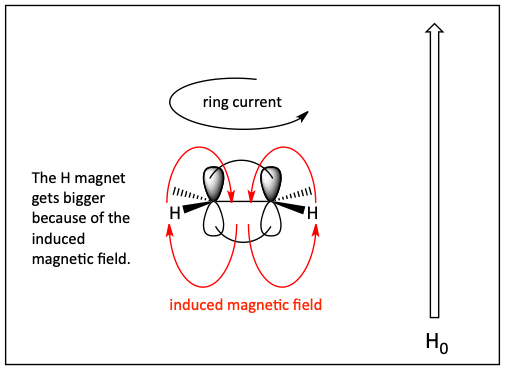Chemical Shifts
The chemical shift is the location of the NMR peak in ppm. In the NMR spectrum for methanol, the chemical shift for the methyl protons is around 3.4 ppm and the chemical shift for the hydroxyl proton is around 3.9 ppm. The chemical shift for a proton depends on the electron density around the proton. We’ve learned the more shielded it is (the more electron density around the proton), the more upfield the chemical shift. The more deshielded it is (the less electron density around the proton), the more downfield the chemical shift. Sometimes, the Greek symbol delta, δ, is used to describe a chemical shift in ppm. For instance, you might see the chemical shift for the hydroxyl proton of methanol written as δ3.9 or δ3.9 ppm.

1H NMR spectrum of methanol
The following chart should be memorized to have a general idea of the chemical shifts for various types of protons.

General location of peaks in 1H NMR spectrum
Regular, aliphatic protons show up around 0.5 to 1 ppm. If there is a special group next door to a proton, it begins to be pulled downfield. If a carbonyl group is next door, a proton’s resonance is around 2-3 ppm because an oxygen atom is three bonds away and begins to pull electrons away from the proton. If a special group like an oxygen or a halogen atom is next door, it is two bonds away from the proton and deshields the proton even more. These protons show up around 3-4 ppm. Protons on double bonds show up around 5-6 ppm and protons on aromatic rings show up around 7 ppm. This may seem strange at first because there are no electronegative atoms on these compounds to pull electron density away from protons. An interesting phenomenon happens which causes these protons to show up in this area. Let’s look at the aromatic ring situation first.
Deshielding of benzene and alkene protons
A benzene ring contains three pi bonds that overlap around the entire ring. This overlapping of pi electrons can be thought of as a loop of wire. Inside an external magnetic field (H0), a current of electrons flows around this ring- a ring current. When a current of electrons flows around a wire loop, which induces a magnetic field, just like in an electromagnet. This induced magnetic field reinforces the magnetic field of H0. In effect, the little magnets of the protons on the benzene ring get a little bigger because of this induced magnetic field. They become harder to flip and end up going more downfield (as if they are deshielded) to around 7 ppm. In fact, since they go downfield, these protons are called deshielded protons.

Why benzene protons are deshielded
For a double bond, a similar phenomenon is occurring. Once again, there is a pi bond because of the double bond. The external magnetic field, H0, makes a ring current in the pi bond. This is smaller than in the benzene ring because there are fewer electrons in the double bond system. This induces a small magnetic field which causes the protons on the double bond to become slightly bigger magnets. They resonate around 5-6 ppm, not as far downfield as benzene protons.

Why alkene protons are deshielded
Deshielding of aldehyde and carboxylic acid protons
Aldehyde protons appear between 9-10 ppm because the proton is near a double bond, pi bond so there is an induced magnetic field AND there is an electronegative oxygen atom nearby. The proton of a carboxylic acid is very far downfield around 11-12 ppm for the same reasons as the aldehyde, but it is even further downfield because there is another oxygen atom directly attached to the proton.
3. Give an approximate 1H NMR chemical shift for each marked hydrogen atom in these compounds.
a)

b)

c)

d)

e)

f)

Answers
3.


